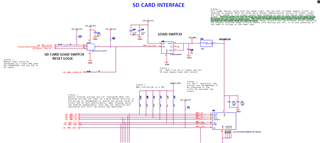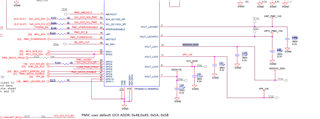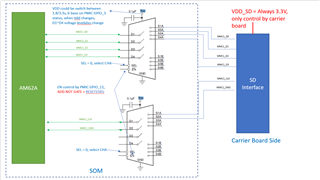- Ask a related questionWhat is a related question?A related question is a question created from another question. When the related question is created, it will be automatically linked to the original question.
This thread has been locked.
If you have a related question, please click the "Ask a related question" button in the top right corner. The newly created question will be automatically linked to this question.
Tool/software:
Hi. Dear Expert.
Because of design consideration, customer may remove "VDD_MMC1_SD" SD Load switch.
EVM ref as below.


D-Note,
This power switch, along with the reset logic, and the host IO power supply circuit is required to support UHS-I SD Cards which begins communications using 3.3V signal levels and later change to 1.8V signal levels when changing to one of the faster data transfer speeds. Cycling power to the SD Card is the only way to put it back into 3.3V mode since SD Cards do not have a reset pin. The host IO power supply must power off/on and change voltage at the same time as the SD Card.
Here are some question :
(1) VDDSHV_SDIO is controlled by VOUT_LDO1 from PMIC. How does PMIC know to change VDDSHV_SDIO between 3.3V to 1.8V from SD-default speed to UHS?
(2) Is RESETSTATz "active low" again when AM62A execute software reboot (Linux reboot)?
(3) When we remove "LOAD SWITCH (TPS22918DBVR)", and let VDD_MMC1_SD always keep 3.3V. It means SD do not have chance to reset & return default speed.
I think VDDSHV_SDIO from PMIC VOUT_LDO1 should be return to 3.3V, but SD I/O level should be keep 1.8v (mmc1_d0~d3). Does it have any damage?
Many Thanks
Gibbs
The PMIC LDO1 output is controlled by the two PMIC inputs GPIO5 and GPIO11, where GPIO11 turns off the LDO1 output at the same time the SD Card power is turned off, and GPIO5 selects the output voltage of LDO1. LDO1 will always start at 3.3V and the SD Card will always begin using 3.3V for its IO power. This allows the MMC1 IO power rail to be at the same operating voltage of the SD Card IOs. If software detects a UHS-I card it will send a command to the SD Card telling it to change its IO voltage from 3.3V to 1.8V, and it will also toggle the GPIO5 input to the PMIC at the same time so the IOs of both devices change IO operating voltage at the same time. If software needs to reset the SD Card, it toggles the GPIO11 input to the PMIC which also turns off the 3.3V load switch sourcing the SD Card. This way the MMC1 IOs are turned off when the SD Card is turned off. The PMIC will always place the LDO1 output back into 3.3V mode any time it is re-enabled, and the SD Card will always power up in 3.3V mode.
The MCU_RESETSTATz and RESETSTATz Switching Characteristics section in the datasheet describes the RESETSTATz function during a software initiated warn reset.
Regards,
Paul
I forgot to mention, the customer should not remove the 3.3V load switch. The load switch is required to cycle power to the SD Card. The SD Card pins that connect to MMC1 signals are not fail-safe and the AM62A pins associated with the MMC1 signal functions are not fail-safe. Therefore, the IOs must power-up and power-down at the same time.
This requirement is defined by the "Steady-state max voltage at all other IO pins" parameter in the Absolute Maximum Ratings table.
Regards,
Paul
Hello, Paul
Many thanks you replies.
I finish talk with our customer, their product is AM62A (SOM), and SD interface is on carrier board, carrier board is fix design and we can not change it.
The power supply (vdd_sd) of SD interface is on carrier board and always keep 3.3v, which is not control by SOM (AM62A), so it means SOM can not turn off/on vdd_sd.
Here is our draft purpose, we try to use "Powered-Off Protected Switch" (TMUX1574) to solve this problem ( I/O fail-safe.).
https://www.ti.com/product/TMUX1574

Few question:
(1) Base on this draft purpose, even we add switch, SD Card is still not return to default speed mode (3.3V I/O), because we do not turn off VDD_SD for SD reset, Am I correct?
(2) Base on item1, When AM62A return to default speed, but SD Card is still keep in UHS, it should be have different I/O level between AM62A & SD, Does it have some damage on SD or AM62A?
(3)If we modify SW, and let AM62A mmc1 fix work on default speed (3.3v), Is it ok?
(4) Try to let vdd_sd turn off/on power when mmc1 interface reset even which is not control by AM62A?
(5) or Any suggestion?
Many Thanks
Gibbs
Hi Paul:
Here is the queseions from our customer could you please help to check and give us the suggestions? Thanks.
I think the question is a bit misunderstood. The SD-card boots in 3.3 mode and then during initial negotiation, the SD card changes to 1.8V mode. Therefore there should be a level translator to allow the SOM to access the SD-card in both 3.3V mode and 1.8V mode and it will always protect the SOM. For a controlled reboot, we will imlkement a software where the SOM sends a message to the carrier board power control system that will perform a hard reset where the power supply for the SD-card will be cut - and the SD-card will then start in initial 3.3V state. The only case that we would like your assessment of is in case of an unwanted reboot of the SOM - an error situation where the SOM gets into initial state while the power cycling on the carrier board has not be done. In this case the SOM level translator will start in 3.3V mode for signals to the SD-card while the SD-card is still in 1.8V mode - in such case, the boot will not happen, and we will implement a timeout and send message to the carrier board to recycle power. But in this mode where the level translator is sending 3.3V signals into the SD-card which is in 1.8V mode - could this harm the SD-card?
Our proposal for solution is to apply a single flip-flop that controls the SD card side voltage - it can be set by the SOM to switch to 1.8V by clocking a "1" to the flip-clop. The only possible way to get it to 0 is if power is recycled. This will prevent the SD card side from not going to 3.3 mode unless power is recycled.
They will never be able to change the IO operating voltage of the SD Card from 3.3V to 1.8V if they are not going to change the carrier board and add a load switch. This means they will need to restrict the software operating modes to one of the two legacy speeds (Default Speed or High Speed).
For this case, there is no reason to have a selectable dual-voltage IO power source for the AM62Ax IO power rail. They could power the AM243x IO power rail from a fixed 3.3V power source. However, the SD Card and the AM62Ax IO power rail need to be powered from the same fixed 3.3V power source so they power-up and power-down at the same time.
Questions 1 and 2: These questions are not relevant since it is not possible to support any of the UHS-I modes without the SD Card load switch.
Question 3: This is what they need to do if they are not willing to add the load switch.
Question 4: I do not understand how the SD Card can be turned on/off if there is no load switch. As mentioned above, the AM243x IO power rail needs to be turned on/off at the same time as the SD Card.
Question 5: My first suggestion is to redesign the carrier board and add the SD Card load switch. My second suggestion is to operate both from the same fixed 3.3V power source and restrict the software to only use Default Speed or High Speed.
Regards,
Paul